An all new round-up of Asian spots that garnered themselves a visit….
AZIT Chickenbar, Ruperto Godoy 733, Floresta [w3w: uniforms.beats.noting] – Located on this new little gastronomic alleyway, right next to Chung, the Korean-Chinese spot which I reviewed recently, no surprise, this place specializes in chicken. Specifically, Korean fried chicken, in several different versions, from mild to super hot, and with various combinations of side dishes. They also have a few other offerings on the menu, but chicken is their raison d’etre.
Now, most Korean fried chicken places, if you’re solo, you’re kind of screwed, because virtually all of them seem to offer the chicken only as a whole chicken, cut up, or a plate of wings, but even those, far too many for a solo diner. And, that’s all that was on the menu – I was resigning my self to eating half, and bringing the rest home, when the waiter offered that at lunchtime, they have a special combo (not on the menu) of half a chicken, your choice of sauce, with salad, pickles, egg and rice, and a soft drink. 280 pesos. [Closed, I think early 2024]
Worth it. Seriously, a complete steal. Of all the places I’ve tried Korean fried chicken here in town, both the two other dedicated spots, Dagi Myeoni and Chicken The Pub, as well as other Korean restaurants that just offer it on their menus, this place blows them all away. Juicy chicken, perfectly cooked, crispy crust that crackles when you bite into it, a tangy, sweet, and yes, on the “hot” version, picante sauce. Fair warning – the “hot picante”, as opposed to the simply “picante”, is super hot. They also have a couple of non-spicy versions. I sweated my way through a dozen napkins. And having the little side dishes makes it both a real meal, and gives some relief. The cooling pickles, the fresh salad, and even the simple… blandness… of rice with a properly fried runny egg on it, all combine to make it a better experience than just a plate of chicken.
Bao Kitchen Noodles & More, Av. Pueyrredón 1790, Recoleta [w3w: swaps.tangible.nibbled] – a newly opened offshoot of Bao Kitchen downtown, offering up a limited menu, and for the moment, limited hours (evenings only, Monday to Saturday, plus Saturday midday) now open lunch and dinner, Monday to Saturday.
Their classic panceta, or pork belly, guabao (150 pesos). It looks and tastes exactly the same as the ones they serve downtown, albeit I’m not sure that all the green tinted plates are the best choices. But something was different. The textures were off. The pork belly isn’t as soft and unctuous, it was still a touch chewy, and the bun itself just sort of fell apart and stuck to the paper.
I realized, thinking about it, that downtown, they have such rapid turnover because they’re always full, that the buns get served almost as fast as they get steamed through. Here, with very little business as of yet, the buns sit in the steamer and get soggy. Until business picks up, they probably should put fewer buns in the steamer at a time….
They offer two types of dumplings, and you know me, I wasn’t going to pass on either of them. The Hun Tun Hong You, or wontons, which downtown are, as far as I know, only offered in a soup, here, are succulent and delicate, and served in a bowl with a spicy chili and peanut sauce. I could just go back and eat my way through three or four bowls of those… even at 320 pesos for a mere 8 of them.
Then again, that’s a better deal than the Jiao zi, the potstickers, which are likewise packed with prawns and pork, and beautifully cooked, but good as they are, I’d still go back for the wontons. And these run 360 pesos for 6. That’d be expensive even in New York City!
A second visit, for takeout. This time a bondiola, or pork shoulder, guabao. I liked this one a bit better – it has more filling in it, and the pork was cooked perfectly. While I was waiting for my order, the owner was sampling one of their “curry puffs” – more or less a curried chicken empanada, but with a different type of pastry, delicious! I’ll have to pick some of those up to snack on. We also got an order of the spicy dumplings again.
And, to share, their Chinese barbecued ribs – succulent, falling off the bones. I could have used a little less sweet and a little more spicy to the sauce, but that’s just personal, they were great as is. 380 pesos.
This place is definitely going to be a regular for me here – particularly on Saturday afternoons when I’m prepping for Casa SaltShaker dinners – I can grab a quick lunch just three blocks away. It’s also really nice to finally have a decent place for Chinese food, even if a limited menu, here in the neighborhood.
In my efforts to find the hidden away spots in the two Koreatowns, I’ve taken to walking the streets, and just watching for places that people seem to be going into, or, as in this case, I overheard the sounds of a kitchen through that small window at the back right, peeked in, saw that it was obviously a restaurant kitchen, and followed around to the doorway, where, although there was no sign, there was a bell. Pushed it, asked the young woman who came to the door if it was Korean food, and, it was.
Dae Jang Geum, Felipe Vallese 3299, Floresta [w3w: scam.owes.sugar]. Two dining rooms, and a good number of Koreans having lunch, I got a few curious glances, but no more than that. And yes, another spot with a Korean only menu…. [Closed permanently during the 2020 pandemic]
…the menu translated for your use. No guarantees they don’t change it, of course. And a couple of dishes were unfamiliar to me, so I may have the translations slightly off, but they should be roughly correct. I don’t know if the reason the calamari dish doesn’t have a price is because it changes depending on market price – though calamari is generally pretty inexpensive here, but I did ask, and they do have it, at least at the moment, it’s 300 pesos like the other stir-fries.
Over the years, I’ve gotten the sense that Korean restaurants here don’t really “do” appetizers. Other than large shared plates of dumplings, and those seem to only be offered at certain types of more social spots, or more expensive spots, like Bi Won or Una Canción Coreana. “Regular” restaurants don’t seem to generally have them. But, these folks had two varieties of Jumuk-Bap – stuffed rice triangles wrapped in nori sheets. Basically the same thing as Japanese onigiri, though the offerings here are stuffed with kimchi and tuna, dried fish, or egg, 50 pesos, and I’d happily snack on these anytime.
I think I put any “he’s not going to like Korean food” thoughts to rest when I ordered up the Cheong-guk, the “stinky tofu” soup, packed with tofu, fermented beans, and kimchi. Yum. And better than the one they used to serve at Kil Jung – which, I asked if they knew what happened, and they said that as a restaurant it closed, that the owners are now doing home delivery of Korean food to folk in the neighborhood – so that ends the search for trying to find where they moved to. This one very neatly fit that funky, spicy, spot. 280 pesos, is another complete steal when you figure it includes rice and all the ban chan – nice array of it here, too….
…the usual staples, like kimchi – a not particularly spicy version, pickled daikon, beansprouts, sauteed watercress… and some interesting not usual suspects, like sweet beets, and a julienned potato salad.
It was all good enough that I grabbed one of my usual lunch companions and headed back a couple of days later for another round. And I like that the ban chan gets some changeouts, with roasted sweet potatoes, and this time a spicy kimchi, and sauteed zucchini.
We shared a couple of dishes, starting off with a beautiful, spicy yukgaejang, beef soup with tofu skins and sweet potato noodles. The broth was rich enough that we both thought it almost seemed like an oxtail broth. 300 pesos
And then finished off with an elaborate version of tteokbokki, rice cakes in spicy sauce, with both the cylindrical and the flat sheet type rice cakes, glass noodles, a mix of vegetables, hard boiled egg, kimchi, and a rocking good and spicy sauce. 300 pesos.
All in all, a winner. Easily tops the food that I used to get at Kil Jung. The place doesn’t have the variety of dishes that somewhere nearby like Singul Bongol has, but it’s slightly less expensive, and more flavorful. I can sacrifice some variety for quality, and nothing precludes going back and forth. Plus, there’s still more “hidden” Koreatown to uncover. Two visits easily puts this place into my top five for Korean cooking.
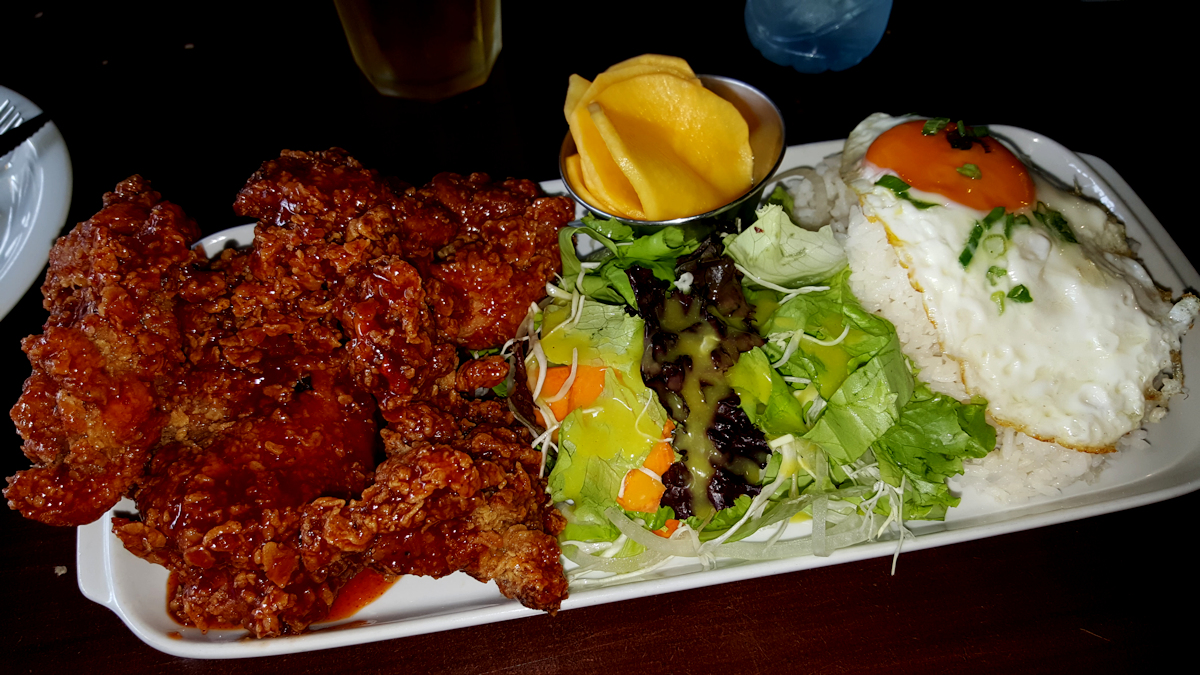
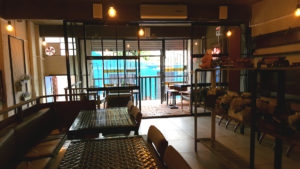
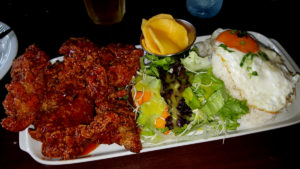
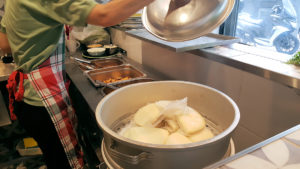
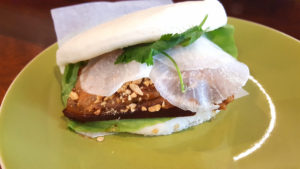
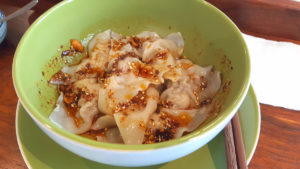
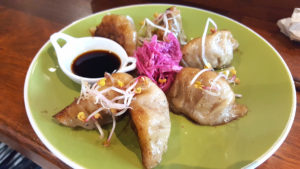
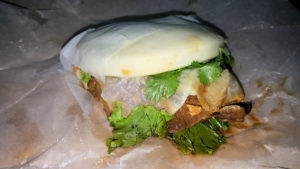
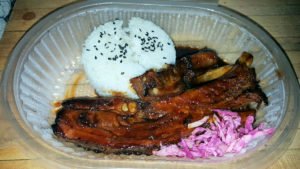
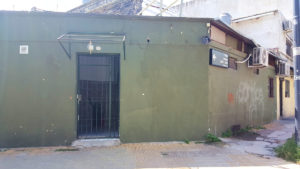
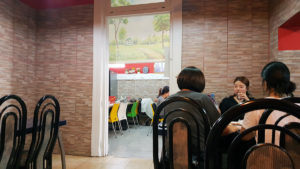
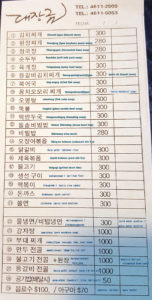

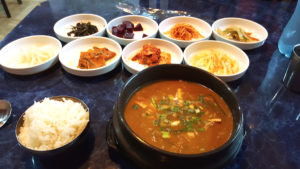
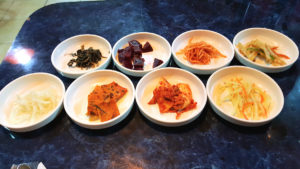
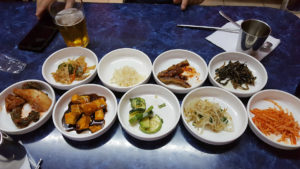
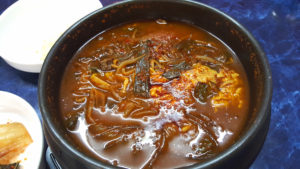
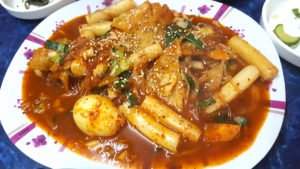
[…] going to make the trip to Floresta, I’d much rather eat the chicken at Dagi & Myeoni or AZIT Chickenbar, both of which are within 2-3 blocks of this […]
[…] and broken up cobblestones? Ruperto Godoy. Now populated by a cafe, two bars, a shabu-shabu bar, a Korean fried chicken place, a Chinese-Korean jungwha yori spot, a fancy looking sushi bar, and now, a spot for traditional […]
[…] get those log or lozenge shaped rice cakes in a chili, onion, and garlic sauce – see here or here. Our waitress brought a little tabletop propane burner, and a huge pot (this is enough for 3-4 […]
[…] had Korean food, but quite good. Really nice people – friendly and helpful. And given that Dae Jang Geum, a few steps away at the corner, closed up permanently during the pandemic, it may be one of the […]
[…] the closing up earlier this year of Azit, we lost what I considered to be the best Korean fried chicken place in town. As best I know, we […]
[…] As long as we’re talking bao, let’s hit up on Bao Kitchen, San Martín 960 in Retiro. Well known folk for the last few years, having shown up at many a street food festival hawking their wares, they now have a brick and mortar spot in the downtown area, across the street from Filo and Dada, popular neighborhood spots. Not surprisingly, the specialty here are the gua bao, which are available in braised pork belly, braised pork shoulder, and braised organic chicken. The steamed buns are noticeably bigger than at the other three spots in town, or really than I’ve seen anywhere (90 pesos for a plate of two). The fillings are delicious, particularly the chicken. However, I found that with the bigger bun, the filling felt a bit meager in contrast – no complaint about the flavor, but the ratio made it feel very “bready”. Fried chicken wings, likewise – these are the biggest wing sections I think I’ve ever seen. Great coating. The dipping sauce is barely a tablespoon of a sweet, hoisin type syrup, certainly not enough to go around – then again, it may have been intended as dressing for the greens, in which case, the chicken needs something to dip it into. [Closed, moved to Av. Pueyrredón 1790, Recoleta] […]